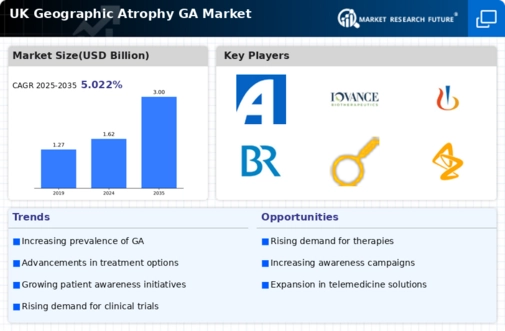Increasing Aging Population
The demographic shift towards an older population in the UK is a primary driver for the geographic atrophy-ga market. As individuals age, the risk of developing age-related macular degeneration (AMD) increases significantly. Current estimates suggest that approximately 1.5 million people in the UK are affected by AMD, with a notable portion progressing to geographic atrophy. This growing patient population necessitates enhanced healthcare services and treatment options, thereby stimulating market growth. The geographic atrophy-ga market is likely to see increased demand for innovative therapies and management strategies tailored to this aging demographic. Furthermore, the rising awareness of eye health among older adults may lead to earlier diagnosis and intervention, further propelling market expansion.
Rising Healthcare Expenditure
The increasing allocation of resources towards healthcare in the UK is a significant driver for the geographic atrophy-ga market. Government spending on health services has been on the rise, with a focus on improving access to treatments for chronic conditions, including AMD. In 2025, healthcare expenditure is projected to reach approximately £200 billion, reflecting a commitment to enhancing patient care. This financial support is likely to facilitate the development and distribution of new therapies within the geographic atrophy-ga market. Additionally, as healthcare providers invest in advanced diagnostic tools and treatment options, patients may benefit from improved access to care, ultimately driving market growth.
Growing Awareness and Education
There is a notable increase in public awareness and education regarding eye health and conditions such as geographic atrophy in the UK. Campaigns aimed at educating the population about the risks and symptoms of AMD are becoming more prevalent, leading to earlier detection and treatment. This heightened awareness is likely to result in a larger patient base seeking medical advice and intervention, thereby expanding the geographic atrophy-ga market. Furthermore, healthcare professionals are increasingly prioritizing patient education, which may empower individuals to take proactive steps in managing their eye health. As a result, the market could experience a surge in demand for both diagnostic and therapeutic solutions.
Technological Innovations in Treatment
Recent advancements in treatment modalities for geographic atrophy are poised to transform the geographic atrophy-ga market. Innovative therapies, including gene therapy and novel pharmacological agents, are under investigation and show promise in slowing disease progression. The UK has seen a surge in clinical trials focusing on these cutting-edge treatments, with several candidates demonstrating efficacy in preliminary studies. For instance, the market could witness the introduction of therapies that target specific pathways involved in retinal degeneration. As these innovations gain traction, they may not only enhance patient outcomes but also attract investment into the geographic atrophy-ga market, fostering a competitive landscape that encourages further research and development.
Regulatory Support for Innovative Therapies
The regulatory environment in the UK is becoming increasingly supportive of innovative therapies for geographic atrophy. Regulatory bodies are streamlining the approval processes for new treatments, which may encourage pharmaceutical companies to invest in research and development. This trend is particularly relevant as the geographic atrophy-ga market seeks to introduce novel therapies that address unmet medical needs. The UK government has also initiated programs aimed at expediting access to breakthrough therapies, which could significantly impact market dynamics. As a result, the geographic atrophy-ga market may witness a faster introduction of effective treatments, ultimately benefiting patients and healthcare providers alike.





















Leave a Comment